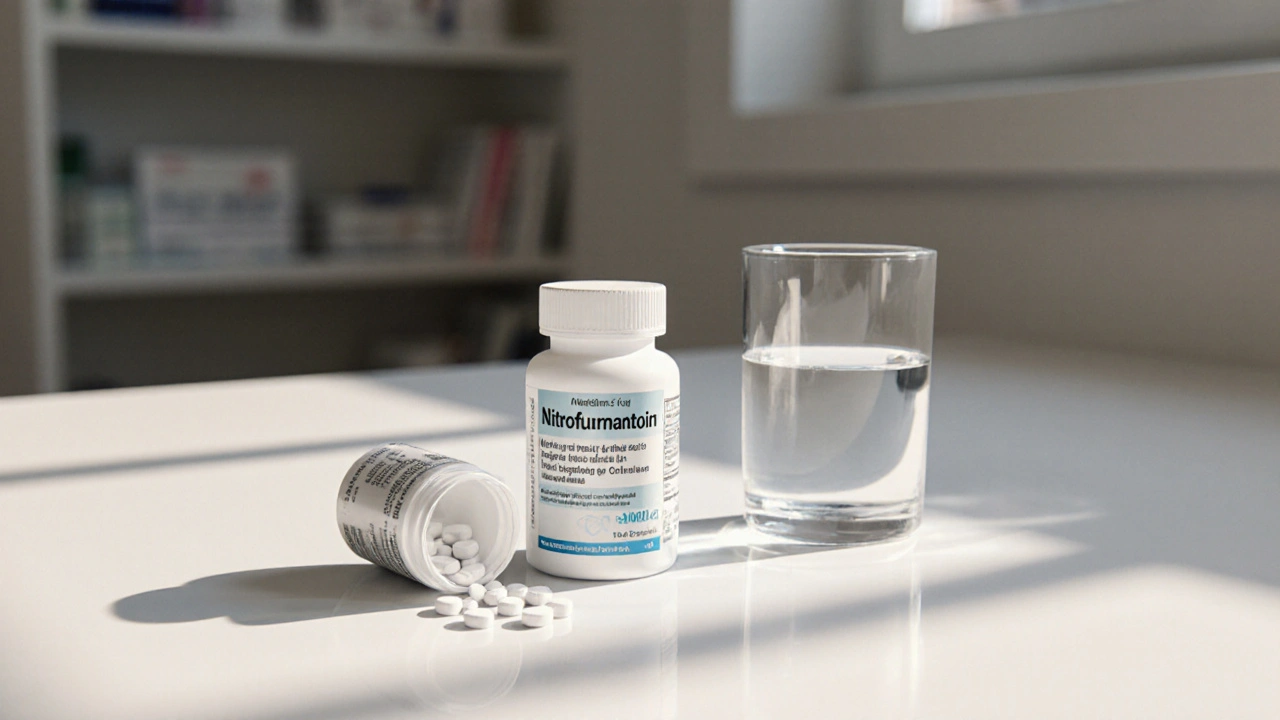UTI Antibiotic Choice Guide
Patient Assessment
Use this tool to determine the most appropriate antibiotic for uncomplicated UTI treatment based on patient-specific factors.
Recommended Treatment
Comparison Table
| Antibiotic | Dosage | Duration | Resistance (2024 UK) | Best For |
|---|---|---|---|---|
| Nitrofurantoin | 100 mg BID | 5–7 days | 8% | Normal kidney function |
| Fosfomycin | 3 g single dose | Single dose | 6% | Adherence issues |
| TMP-SMX | 160/800 mg BID | 3 days | 22% | Low resistance areas |
| Ciprofloxacin | 250 mg BID | 3 days | 12% | Complicated cases |
| Amoxicillin-clavulanate | 500/125 mg TID | 5–7 days | 15% | Mixed flora |
When treating uncomplicated urinary tract infections, Nitrofurantoin is an oral antibiotic that concentrates in urine and is primarily used for lower urinary tract infections caused by susceptible bacteria. It has been a go‑to choice for many clinicians because it stays largely out of the bloodstream, limiting systemic side effects. However, rising resistance patterns and patient‑specific factors have sparked a search for alternatives. This guide walks through the most frequently considered substitutes, compares their key attributes, and helps you decide which drug fits best in different scenarios.
Key Takeaways
- Nitrofurantoin works best for uncomplicated cystitis caused by Escherichia coli, especially when kidney function is normal.
- Fosfomycin offers a single‑dose regimen and retains activity against many multidrug‑resistant strains.
- Trimethoprim‑sulfamethoxazole remains inexpensive but faces higher local resistance in parts of the UK.
- Ciprofloxacin provides excellent tissue penetration but carries higher risk of tendon and cartilage toxicity.
- Amoxicillin‑clavulanate can be useful for mixed‑flora infections but may cause more gastrointestinal upset.
Why Look Beyond Nitrofurantoin?
Even though Nitrofurantoin is effective for many patients, several situations push clinicians toward other agents:
- Renal impairment (creatinine clearance<60ml/min) reduces urinary concentrations, making the drug less reliable.
- Allergy or intolerance (e.g., pulmonary fibrosis, severe nausea).
- Local resistance data showing >20% resistance among uropathogens.
- Need for a shorter treatment course or once‑daily dosing for adherence.
Top Alternatives at a Glance
Below is a side‑by‑side snapshot of the most common nitrofurantoin substitutes. Data reflect UK‑wide surveillance reports from Public Health England (2024) and the British Association of Urological Surgeons guidelines.
| Antibiotic | Typical Adult Dose | Course Length | Primary Spectrum | 2024 UK Resistance Rate* | Common Side Effects | Best Use Scenario |
|---|---|---|---|---|---|---|
| Nitrofurantoin (Macrobid) | 100mg twice daily | 5‑7days | Gram‑negative uropathogens (E.coli, Enterococcus) | 8% | Nausea, pulmonary reactions (rare) | Normal renal function, lower urinary tract infection |
| Fosfomycin single‑dose oral granule | 3g once | Single dose | Broad Gram‑negative & some Gram‑positive | 6% | Diarrhea, transient nausea | Patients with adherence challenges or slight resistance to nitrofurantoin |
| Trimethoprim‑sulfamethoxazole (TMP‑SMX) | 160/800mg twice daily | 3days | Gram‑negative uropathogens, some MRSA | 22% | Rash, hyperkalemia, rare Stevens‑Johnson syndrome | Cost‑sensitive patients in regions with low resistance |
| Ciprofloxacin fluoroquinolone | 250mg twice daily | 3days | Broad Gram‑negative & intracellular organisms | 12% | Tendonitis, QT prolongation, photosensitivity | Complicated UTIs, suspected pyelonephritis, when rapid tissue penetration is needed |
| Amoxicillin‑clavulanate beta‑lactam combo | 500/125mg three times daily | 5‑7days | Mixed Gram‑positive & Gram‑negative flora | 15% | Diarrhea, liver enzyme elevation | Mixed‑infection cases or when beta‑lactam therapy is preferred |
*Resistance rates are averages from the 2024 UK Antimicrobial Resistance Surveillance Programme.
How to Choose the Right Agent
Think of the decision as a flowchart. Start with the patient’s renal function, allergy history, and local resistance patterns. Then weigh convenience (once‑daily vs. multiple doses) against the infection’s severity.
- Good kidney function (eGFR≥60ml/min) and no nitrofurantoin allergy? Stick with nitrofurantoin - it’s cheap and well‑tolerated.
- eGFR<60ml/min? Switch to fosfomycin or a fluoroquinolone, because nitrofurantoin won’t reach effective urinary concentrations.
- History of tendon problems or recent fluoroquinolone exposure? Avoid ciprofloxacin and consider TMP‑SMX (if local resistance is low) or fosfomycin.
- Adherence is a concern (e.g., elderly patient forgetting doses)? A single‑dose fosfomycin regimen can dramatically improve completion rates.
Side‑Effect Profiles at a Glance
Side effects often dictate real‑world choices more than raw efficacy numbers. Below is a quick comparison:
| Antibiotic | Most Common Mild AE | Rare but Serious AE |
|---|---|---|
| Nitrofurantoin | Nausea, headache | Pulmonary fibrosis (very rare, >6months use) |
| Fosfomycin | Transient diarrhea | Allergic rash |
| Trimethoprim‑sulfamethoxazole | Rash, mild GI upset | Severe skin reactions, hyperkalemia |
| Ciprofloxacin | GI disturbance, dizziness | Tendon rupture, QT prolongation, Clostridioides difficile infection |
| Amoxicillin‑clavulanate | Diarrhea | Liver enzyme elevation, rare anaphylaxis |
Resistance Trends and Future Outlook
Resistance data are dynamic. In the UK, nitrofurantoin has held steady under 10% resistance for the past decade, thanks to its unique mechanism (DNA damage via reactive intermediates). Fosfomycin’s resistance remains low but is on the rise in regions where it’s used as a rescue drug. TMP‑SMX resistance hovers around 20‑25% in many areas, prompting clinicians to request susceptibility testing before prescribing. Fluoroquinolone resistance has climbed to double‑digits, driven by over‑prescribing in respiratory infections.
Looking ahead, new oral agents such as gepotidacin are in late‑stage trials, promising activity against multidrug‑resistant uropathogens. Until they become available, the current toolbox remains essential, and stewardship-using the narrowest effective agent-will keep resistance rates manageable.

Practical Prescribing Checklist
- Confirm uncomplicated cystitis (no flank pain, no fever).
- Check creatinine clearance; if <60ml/min, avoid nitrofurantoin.
- Review allergy list for sulfa or fluoroquinolone reactions.
- Consult local resistance map (hospital labs often publish quarterly data).
- Select the shortest effective course that fits patient lifestyle.
- Provide clear instructions: take with food (if required), complete the full course, watch for rash or GI upset.
Frequently Asked Questions
Can I use nitrofurantoin if I have a mild kidney problem?
If your estimated glomerular filtration rate (eGFR) is between 40 and 60ml/min, many clinicians still prescribe nitrofurantoin but reduce the dose or monitor urine concentrations. Below 40ml/min, its effectiveness drops sharply, so a different drug is preferred.
Is a single dose of fosfomycin enough for a typical bladder infection?
For most uncomplicated cases caused by susceptible E.coli, a 3g single dose achieves urinary concentrations above the MIC for 24‑48hours, which is sufficient. However, if the infection recurs quickly, a longer course or a different agent may be needed.
Why is trimethoprim‑sulfamethoxazole still prescribed despite rising resistance?
Its cost is very low, and in many rural practices the local resistance stays under the 20% threshold. When a urine culture shows susceptibility, TMP‑SMX remains an effective, affordable option.
Are fluoroquinolones safe for young adults with uncomplicated UTIs?
They are generally effective, but the FDA and MHRA have issued warnings about tendon rupture and cartilage damage, especially in patients who are very active or pregnant. Reserve them for cases where other agents fail or for suspected kidney involvement.
What should I do if I develop a rash while taking nitrofurantoin?
Stop the medication immediately and contact your GP. A rash could signal a hypersensitivity reaction. Your doctor may switch you to fosfomycin or a beta‑lactam, depending on your history.
Next Steps for Clinicians and Patients
Take the checklist above, match it with the local susceptibility data, and discuss the convenience factor with the patient. For most adults with normal kidneys, nitrofurantoin remains the first‑line, cost‑effective choice. If any red flags appear-poor renal function, allergy, or high local resistance-pivot to fosfomycin for a single‑dose cure or to a fluoroquinolone for a more aggressive infection.
Staying updated on the 2025 UK antimicrobial guidelines will ensure you’re prescribing the safest, most effective drug for each case.


Sarah Hoppes
Nitrofurantoin is being pushed by pharma to hide the real cure.
William Pitt
Hey everyone, great breakdown of the options – the nitrofurantoin data looks solid, especially for those with normal kidney function, and the table makes it easy to see when alternatives might be preferable.
ashish ghone
First off, thank you for putting together such a thorough guide – it’s exactly the kind of resource clinicians need when navigating the myriad of UTI treatments.
When you look at nitrofurantoin, its low resistance rate of 8 % really stands out, especially compared to the 22 % we see with TMP‑SMX in many UK regions.
That said, renal function is the gatekeeper; if a patient’s eGFR drops below 60 mL/min, you have to pivot quickly to alternatives like fosfomycin or a fluoroquinolone, provided there are no contraindications.
Fosfomycin’s single‑dose convenience can dramatically improve adherence, which is a key factor in real‑world effectiveness.
On the flip side, its spectrum is broader, so you have to watch for potential collateral damage to the gut microbiome.
For patients allergic to sulfa drugs, nitrofurantoin or fosfomycin become first‑line choices, while those with a fluoroquinolone allergy may need to lean on nitrofurantoin or even amoxicillin‑clavulanate if the infection is mixed flora.
The table’s resistance numbers also highlight why ciprofloxacin, despite its superior tissue penetration, should be reserved for complicated cases; the 12 % resistance is still higher than nitrofurantoin’s.
It’s also worth noting the safety profile – nitrofurantoin’s adverse events are mainly gastrointestinal, whereas fluoroquinolones carry the risk of tendonitis and QT prolongation.
In practice, I often start with nitrofurantoin for uncomplicated cystitis, then reassess after culture results to see if a switch is warranted.
One practical tip: always verify the patient’s creatinine clearance before prescribing nitrofurantoin, especially in older adults.
If you’re dealing with a high‑resistance community, the guide wisely nudges clinicians toward fosfomycin or a short course of TMP‑SMX if susceptibility is confirmed.
Overall, the flowchart approach you presented – renal function, allergies, resistance – mirrors the decision‑making process we teach residents.
Keep up the excellent work, and consider adding a quick‑reference pocket card for busy clinicians.
Jesse Najarro
Really appreciate the clear layout the guide offers it makes choosing the right drug feel less daunting for both new and seasoned prescribers alike.
Brad Tollefson
While the guide is comprehensive, I would advise double‑checking the dosing intervals for nitrofurantoin in patients with borderline renal function to avoid sub‑therapeutic exposure.
Albert Gesierich
There are several grammatical inaccuracies in the table headings – “Dosage” should be pluralized to “Dosages” to match the content, and “Duration” needs a consistent unit notation (days vs days).
Dan Dawson
Nice work the guide is solid and easy to read.
Robert Frith
Honestly this nitrofurantoin hype is just another case of the “British med‑establishment” pushing cheap meds while ignoring the real cure that’s been out of the market for years.
Jeff Hershberger
While I see your point, the data on nitrofurantoin’s resistance trends remain robust – it’s not a relic but a reliable tool when used correctly.
steph carr
Great job putting this together – the step‑by‑step flow is exactly what busy clinicians need to feel confident in their prescribing choices.